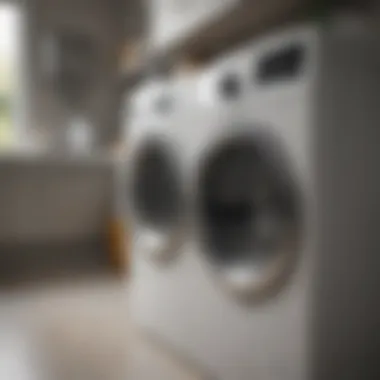How to Choose the Perfect Washer Dryer for Your Home


Intro
Selecting a washer dryer is not merely a task—it's an investment in efficiency and convenience for your home. This decision plays a crucial role in your laundry experience, influencing how you manage your time and resources. It extends beyond the functionality of washing and drying clothes; it also incorporates factors such as size, capacity, features, energy efficiency, and cost. Each of these elements can significantly affect your household's laundry routine.
In this article, we will explore key points that aid in the decision-making process when choosing a washer dryer. The goal is to provide insights that cater to the needs and preferences of consumers. By understanding essential specifications and navigating technical terms, homeowners can effectively compare various models and select the one that aligns best with their lifestyle.
From understanding the current market trends to comprehending the nuances of operational efficiency, this guide is designed to empower readers with knowledge, allowing them to make informed choices.
We will discuss practical aspects such as the dimensions of your space and the capacity required for your household. You will also find tips on evaluating features such as energy ratings and specific functionalities that can impact usage costs over time. This information is meant to clarify the complexities of washer dryer options available today and aid you in finding the ideal laundry solution for your home.
Understanding Basic Washer Dryer Functions
Choosing the right washer dryer involves understanding its fundamental operations. Knowing how these appliances function not only enhances your overall laundry experience but also ensures that you select one that meets your specific needs. A washer dryer combines both washing and drying capabilities, making it a valuable addition to your home. This section will delve into the importance of these functions and their implications for efficiency and convenience.
Washer Dryer Explained
A washer dryer is a versatile appliance that allows users to wash and dry clothes in a single unit. Unlike traditional appliances that operate separately, a washer dryer optimally utilizes space, which is particularly beneficial for those with limited laundry areas. These machines come with various features, such as different wash cycles and drying modes, designed to cater to diverse laundry requirements. With the right appliance, you can achieve excellent cleaning results while minimizing energy and water use.
Selecting a washer dryer necessitates awareness of its dual functions. For instance, the washing function usually includes various settings such as delicate, normal, and heavy-duty washes. The drying function might utilize ventless or vented drying systems, impacting the efficiency and suitability for your home. Understanding these aspects will help you pick a model that aligns with your household's unique laundry routine.
Key Components of Washer Dryers
Washer dryers comprise several crucial components that contribute to their functionality. Here are the main elements to be aware of:
- Drum: The heart of the washer dryer, the drum houses your clothes during the washing and drying cycles. Capacity varies, so it's essential to consider your average laundry load when selecting a drum size.
- Control Panel: This component allows you to select wash cycles, drying settings, and other features. Familiarity with the control panel can significantly enhance your user experience.
- Pumps and Motors: Pumps are responsible for draining water, while motors power the washing and spinning functions. Efficiency in these components is critical for energy savings and effective cleaning.
- Heating Element: This part is essential for the drying cycle, as it warms air to dry clothes adequately. The efficiency of the heating element can influence both energy costs and drying times.
- Sensors: Many modern washer dryers incorporate sensors that can detect moisture levels and optimize drying times accordingly. This feature not only saves energy but also protects clothes from over-drying.
By understanding these key components, you can better evaluate the performance and reliability of different washer dryer models. Each part plays a vital role in the overall operation, and recognizing their functions will aid in making an informed decision during your selection process.
Assessing Your Laundry Needs
Understanding your laundry needs is crucial in selecting the right washer dryer for your home. This assessment involves considering various factors that impact both your laundry routine and the overall efficiency of the appliance. By clearly defining these needs, you can make an informed choice that aligns with your lifestyle and household demands.
Size Considerations
When assessing your laundry needs, the size of the washer dryer plays a vital role. Measure the space where your appliance will be placed. Consider both the physical footprint and the door clearance required for operation. Standard washers and dryers vary in width, depth, and height. Some may fit snugly in tight spaces, while others might need more room for ventilation.
In addition to the actual dimensions, consider whether you prefer a front-loading or top-loading design. Front-loaders typically use less water and are more energy efficient, but they may require a bit more depth. Top-loaders can often fit in smaller vertical spaces. Assessing this aspect helps avoid installation headaches later.
Expected Load Capacity
Next, it is essential to understand your expected load capacity. How many individuals are in your household? Do you have frequent laundry needs? Identifying the average load size you typically handle will help determine the drum capacity that is right for you. Larger drums can handle bigger loads, reducing the frequency of laundry days, which can be beneficial for busy families.
For example, a capacity of 7-8 kilograms can be adequate for a small family, whereas larger families may need 9 kilograms or more. If you commonly wash bulky items like bedding and towels, opting for a larger unit could enhance your laundry efficiency. This analysis of load capacity ensures that you select a washer dryer that meets your everyday laundry demands without overloading the machine.
Frequency of Use
Lastly, consider the frequency of use for your washer dryer. Knowing how often you will run the machine helps in understanding its impact on your utility bills and wear and tear on the appliance. If you do laundry weekly, a high-efficiency model would be beneficial due to lower running costs. However, for households with daily or multiple loads, investing in a robust unit may provide more durable performance over time.


Take into account your lifestyle and activities. Are you a busy professional, or do you have children who generate frequent wash loads? Clarifying your usage frequency leads to a better purchasing decision that suits your long-term needs.
"Assessing your laundry needs not only streamlines the buying process but can also elevate the overall efficiency of your laundry routine."
In summary, assessing your laundry needs encompasses size considerations, expected load capacity, and frequency of use. Addressing these factors systematically will guide you toward a washer dryer that enhances your everyday life and laundry efficiency.
Evaluating Available Features
Choosing the right washer dryer involves more than just considering size and capacity. One significant aspect that must not be overlooked is the evaluation of available features. The right features can enhance functionality, improve efficiency, and ultimately shape user experience. Understanding these features will help you determine which machine aligns best with your laundry habits and lifestyle, making it a crucial factor in the decision-making process.
Drying Settings and Options
Drying settings play a critical role in how effectively your washer dryer handles different fabric types and laundry loads. Many modern washer dryers come equipped with adjustable drying options. Standard settings might include options for delicate fabrics, heavy-duty items, and even rapid drying for urgent situations.
Using customized drying options not only helps in caring for clothing but also ensures optimal functionality. Overly aggressive drying can damage garments, leading to premature wear.
Some units feature steam drying capabilities. This reduces wrinkles and minimizes ironing time. A user-friendly interface often accompanies these machines, allowing you to select desired settings with ease.
Benefits of Various Drying Settings:
- Protects garment integrity
- Decreases energy consumption with appropriate cycles
- Increases overall efficiency
Washing Programs and Modes
In addition to drying settings, the washing programs and modes available on a washer dryer are equally vital. These programs define how the machine interacts with your laundry load. Basic models may offer only a few standard settings, while more advanced options provide a comprehensive range of cycles tailored to specific materials and stains.
For instance, if you frequently wash wool or silk, look for a washer dryer with gentle cycles specifically designed for these fabrics. Other notable programs may include a quick wash for less-soiled items, or pre-soak options for heavily stained loads.
Having multiple washing modes can significantly impact cleaning effectiveness. It enhances the chances of achieving optimal results without compromising the lifespan of your clothing.
Common Wash Programs:
- Normal: Everyday laundry
- Delicate: For fragile fabrics
- Heavy Duty: For robust items
- Quick Wash: For lightly soiled garments
Smart Technology Features
The advent of smart technology has transformed many household appliances, and washer dryers are no exception. Smart features streamline the laundry process, giving users greater control and convenience. You can often connect these machines to your smartphone, allowing you to start cycles remotely or receive notifications once a load is done.
Some models come with built-in sensors that automatically adjust water levels, cycle times, and temperatures based on the load. This adaptability not only enhances performance but also conserves resources, making it a more environmentally friendly choice.
Moreover, smart technology can assist in troubleshooting by providing alerts for maintenance needs. This proactive approach can help prevent more significant issues later on and extend the lifespan of your appliance.
Advantages of Smart Features:
- Enhanced convenience and accessibility
- Improved efficiency in water and energy use
- Proactive maintenance notifications
Energy Efficiency Considerations
Energy efficiency is crucial in the selection of a washer dryer because it affects both your utility bills and the environmental footprint of household laundry. These appliances consume a significant amount of energy and water, which reflects not only on your expenses but also on broader ecological concerns. As individuals increasingly focus on sustainability, being informed about energy efficiency becomes an essential part of the decision-making process.


When choosing a washer dryer, it's important to assess the energy ratings provided by manufacturers. These ratings are indicative of how efficiently the machine uses resources. Understanding these ratings ensures that you select a model that aligns with both your financial and environmental goals. Furthermore, energy-efficient models often come with advanced features that enhance overall laundry performance.
Understanding Energy Ratings
Energy ratings on washers and dryers typically appear as labels that display a star system. These stars help indicate a model's energy consumption levels. Labeling systems vary by region but generally include an energy efficiency index or points to signify better performance. For example, the European Union introduces energy labels ranging from A+++ to D, with A+++ being the most efficient. By paying attention to these ratings, consumers can make informed choices that reduce electricity usage and lower operational costs.
Also, consider Energy Star certification which signifies adherence to strict energy efficiency guidelines set by the EPA. These machines not only save energy but often include improved features that may enhance usability.
Environmental Impact
The environmental implications of using washer dryers are profound. The vast majority of home appliances contribute to carbon footprints largely due to their energy-dependent operation. More energy-efficient models utilize technology that reduces greenhouse gas emissions by conserving energy and resources. Choosing an eco-friendly washer dryer model aids in reducing the overall demand for energy, which supports the shift toward sustainable practices in household management.
Moreover, the water efficiency of a machine also plays a fundamental role. A washer dryer that employs less water during operation does not just lower your water bills; it positively contributes to water conservation efforts. In regions where water scarcity is a concern, these considerations become even more paramount.
Cost Implications of Energy Efficiency
Investing in energy-efficient washer dryer units may come at a higher initial price; however, long-term savings can offset these upfront costs. By reducing energy and water consumption, households can see a noticeable drop in utility bills. Over time, these savings accumulate significantly. Consider this simple calculation:
- An energy-efficient model might save you up to $100 annually in energy costs.
- Over a span of 10 years, this could translate to $1,000 saved.
Financial incentives like rebates or tax credits may also apply for purchasing energy-efficient appliances, thereby improving the overall affordability.
Comparing Washer Dryer Models
When selecting a washer dryer for your home, one crucial step is comparing different models. This process ensures that you choose an appliance that meets your specific needs while providing the best value for your investment. With many brands and variations available, knowing how to effectively compare these machines can help you avoid common pitfalls and confidently make a decision.
Brand Reputation and Reliability
Brand reputation plays a significant role in the buying decision. Well-established brands often have years of experience, leading to better product designs and customer satisfaction. Aspects such as customer service and durability are critical when evaluating a brand's reliability. Choosing brands like Bosch or LG, known for their high-quality appliances, can lead to a more satisfying experience in the long-term. A reliable brand will usually offer a range of models tailored to different needs, so take the time to check the company’s history and assess their standing in the market before making a purchase.
Consumer Reviews and Feedback
Consumer reviews are a valuable source of information when comparing washer dryer models. These reviews can provide insights into actual performance and potential issues users have encountered. Look for trends in feedback across multiple platforms such as Reddit or Facebook. Positive reviews regarding efficiency, ease of use, and customer service can indicate a good product. Negative trends might suggest reliability issues or design flaws. By taking a deep look at what real users say, you can gauge whether a model might work well for your home laundry requirements.
Warranty and Support Services
A solid warranty and good customer support can make a significant difference in your washing and drying experience. Most washer dryers come with warranties, but the duration and coverage can vary widely by model and brand. Look for comprehensive warranties that cover major components such as the motor and drum. Additionally, consider the support services that manufacturers offer. Efficient customer support can help resolve issues swiftly and ensure that your appliance runs smoothly over time. Investing in a washer dryer with good support is critical to avoid inconvenience in the long run.
In summary, evaluating brand reputation, consumer feedback, and warranty services is essential in comparing washer dryer models. This thorough analysis can lead to a more informed and satisfying choice.
Budgeting for Your Washer Dryer
When selecting a washer dryer, budgeting plays a crucial role. The decision not only involves the upfront cost but also considers the long-term financial implications. Understanding your budget can guide you toward appliances that align with your financial situation and laundry needs. This section addresses both initial purchase costs and ongoing maintenance expenses.
Cost Analysis of Washer Dryers
The market offers a wide variety of washer dryers, leading to price fluctuations based on features, capacity, and brand reputation. Basic models may start around $500, while high-end options can exceed $1,500. It's vital to identify your specific requirements, as this will help in narrowing choices without overspending.
Factors influencing the cost include:


- Brand: Reputable brands often command higher prices due to their reliability and performance.
- Features: Additional functionalities such as smart technology or advanced drying settings can influence costs significantly.
- Energy Efficiency: Models with better energy ratings may carry a higher price tag, but they can contribute to savings in utility bills over time.
Researching various brands and comparing models will provide insight into what you can expect to spend. Look for promotions or sales, especially during holidays, to secure a better deal. Just remember, cheap isn't always better; always consider the value and what comes with the cost.
Long-Term Maintenance Costs
The importance of long-term maintenance costs cannot be undervalued in the total cost of ownership of a washer dryer. While an appliance may appear affordable at first glance, hidden expenses can accumulate over time. Common factors that contribute to these costs include:
- Repairs: Consideration of warranties and what they cover is essential. Some brands offer better coverage or extended warranties, while others may leave you with significant repair bills.
- Replacement Parts: Over time, certain components may need replacement, such as belts and hoses. Understanding the expected longevity of these parts in your chosen model can help with forecasting future costs.
- Energy Costs: Higher energy efficiency doesn’t just save the planet; it also saves you money. Look for the Energy Star certification, which indicates that a model is designed to reduce energy consumption.
In Summary: Throughout your budgeting process, consider both the initial price and the ongoing costs of maintaining your washer dryer. Doing this not only ensures you make a smart purchasing decision but also helps in planning your finances after you settle on a model.
"Investing in a quality washer dryer can lead to savings and convenience in the long run."
Keeping these factors in mind will lead you to a more informed choice in the washer dryer market.
Installation Requirements and Considerations
When selecting a washer dryer for your home, proper installation is crucial. This section will cover the vital elements of installation requirements and considerations. Failing to address installation aspects can lead to inefficient operation or even damage to the appliance.
Space Allocation for Installation
Before purchasing a washer dryer, assess the space where it will be located. Measure the area to determine the fit, ensuring there is adequate room for the unit itself, as well as space for ventilation, accessibility, and maintenance. Many washer dryers require a minimum of a few inches on all sides for proper airflow and functionality.
Consider the door openings. A washer dryer needs enough clearance to allow for door swings without obstruction. This might seem simple, but miscalculations could lead to frustrating situations later. It is also vital to factor in the height of the unit to prevent issues when loading or unloading laundry.
Additionally, think about surrounding furniture or appliances that could impede access. If the washer dryer is placed in a tight area, ensure you can reach all sides for operation and serviceability. The right placement can optimize usage and create a more convenient laundry experience.
Plumbing and Electrical Specifications
Installation of a washer dryer involves more than just fitting it into the available space. It must connect to existing plumbing and electrical systems, which necessitates specific considerations. Both the washing function and the drying process demand adequate water supply and drainage options. Ensure that access to cold and hot water connections is available.
For electrical requirements, standard 120-volt outlets are usually sufficient. However, some high-efficiency models may need 240-volt outlets, especially for drying. Knowing your current electrical capacity and any potential need for upgrades is essential.
Additionally, check if the location meets local building codes regarding plumbing and electrical installations. Improper connections can lead to leaks, mold growth, or other serious issues. Be mindful of the placement of hoses and wiring, ensuring that they are properly secured and not at risk of being pinched or damaged.
By carefully evaluating these installation requirements, you can help guarantee that your washer dryer not only fits in the space but also operates efficiently and safely.
Culmination and Decision-Making Tips
Choosing the right washer dryer is a multi-faceted decision that can affect not just your laundry routine, but also your home's overall efficiency and comfort. In this conclusion, it’s important to synthesize the key points discussed throughout the article. Understanding the core elements of size, capacity, features, and energy efficiency is essential for making an informed choice. The steps outlined in previous sections provide a structured approach to evaluating your options.
Recap of Key Considerations
When selecting a washer dryer, consider the following:
- Laundry Needs: Assess the frequency and volume of your laundry. Are you oftens washing large loads, or do you need a unit that caters to small, frequent washes?
- Energy Efficiency: Review the energy ratings to ensure your choice is sustainable and cost-effective over time.
- Available Features: Analyze which features matter most to you. Options such as smart technology can enhance your laundry experience but also come with added costs.
- Space and Installation: Be mindful of your installation space, ensuring your chosen unit fits within your home’s design and meets plumbing requirements.
- Cost and Budgeting: Establish a clear budget. Factor in long-term operational costs in addition to the initial purchase price to avoid unexpected financial burdens.
By keeping these points in mind, homeowners can navigate the complexities of the washer dryer market with greater clarity and confidence.
Final Thoughts on Making an Informed Choice
Making a decision on a washer dryer is not merely about selecting a device; it involves careful evaluation of personal needs, environmental considerations, and financial implications. A well-informed choice can lead to significant improvements in your day-to-day laundry experience, enhancing convenience and efficiency.
Remember, a washer dryer is an investment. Approach your decision with diligence for the best results.















